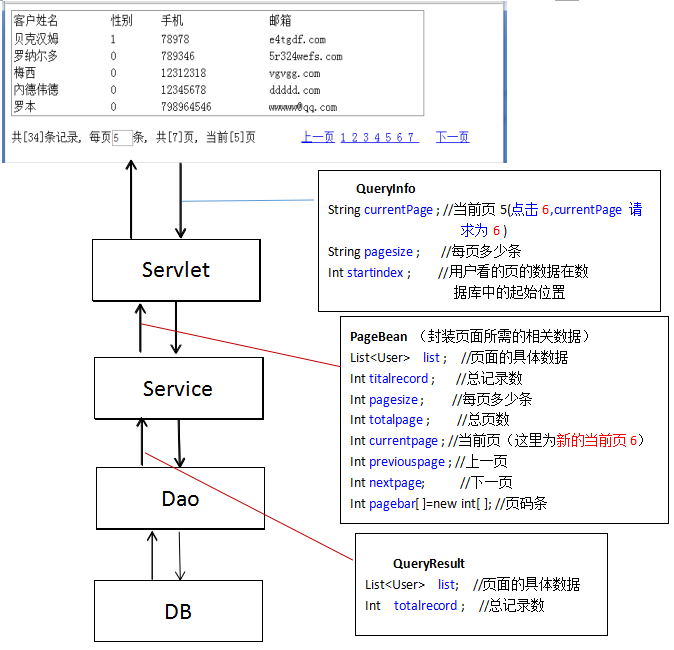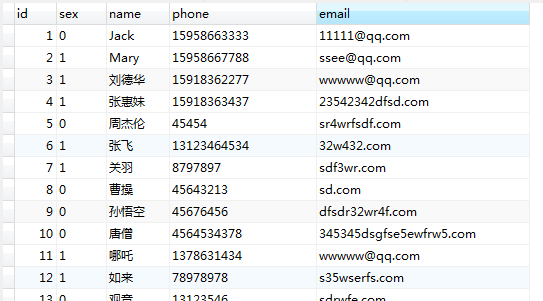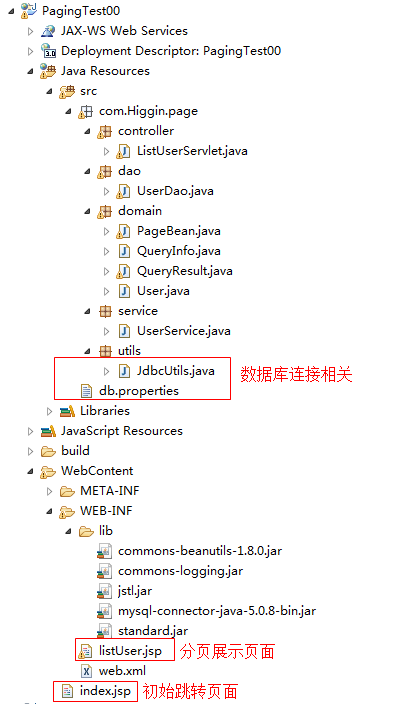02_分页_01_简单设计
2016-08-17 15:51
183 查看
【分页流程图】

【数据库设计】
设计字段

传入一些数据

【工程截图】

一. domain层
【User.java】
【QueryInfo.java】前端发送给Servlet的请求数据
【QueryResult.java】从数据库查询返回的结果,在UserDao体现!
【PageBean.java】在UserService层体现!
前端页面需要的数据如下图所示(对应PageBean):

二.数据库连接相关
【db.properties】
【JdbcUtils.java】
三.Dao层
【UserDao.java】
四.Service层
【UserService.java】
五.controller层
【ListUserServlet.java】(注解方式的Servlet)
六.前端页面展示
【index.jsp】关键代码
【listUser.jsp】
【运行结果】
首先输入http://localhost:8080/PagingTest00,进入了index.jsp

点击“查看客户”,访问路径为http://localhost:8080/PagingTest00/ListUserServlet,访问ListUserServlet.java,然后跳转至listUser.jsp,如下

点击“上一页”、“下一页”、“1 2 3 4 5 6 7”等等都会有不同的变化,并且“当前[X]页”也会相应变化。

【数据库设计】
设计字段

传入一些数据

【工程截图】

一. domain层
【User.java】
public class User {
private int id;
private String name;
private String sex;
private String phone;
private String email;
.......忽略get和set方法
}【QueryInfo.java】前端发送给Servlet的请求数据
package com.Higgin.page.domain;
/**
* 分页界面传递过来的数据
* @author YH
*
*/
public class QueryInfo {
private int currentpage=1; //用户当前看的页 ,默认为1
private int pagesize=5; //记住用户想看的页面大小,默认为5(1页5行)
private int startindex; //记住用户看的页的数据在数据库的起始位置
......//忽略currentpage和pagesize的get和set方法。
public int getStartindex() {
this.startindex=(this.currentpage-1)*this.pagesize;
return startindex;
}
}【QueryResult.java】从数据库查询返回的结果,在UserDao体现!
package com.Higgin.page.domain;
import java.util.List;
/**
* 从数据库中查询的数据
* @author YH
*
*/
public class QueryResult {
private List list; //记住用户看的页的数据
private int totalrecord;//记住总记录数
........忽略两者的get和set方法
}【PageBean.java】在UserService层体现!
package com.Higgin.page.domain;
import java.util.Arrays;
import java.util.List;
/**
* 返回给分页前端界面的对象
* @author YH
*
*/
public class PageBean {
private List list;
private int totalrecord; //总记录数
private int pagesize; //每页显示的记录数
private int totalpage; //总页数,可根据总记录数和每页记录数算出,无需set方法
private int currentpage; //当前页
private int previouspage; //上一页 无需set方法
private int nextpage; //下一页 无需set方法
private int[] pagebar; //页码条
public List getList() {
return list;
}
public void setList(List list) {
this.list = list;
}
public int getTotalrecord() {
return totalrecord;
}
public void setTotalrecord(int totalrecord) {
this.totalrecord = totalrecord;
}
public int getPagesize() {
return pagesize;
}
public void setPagesize(int pagesize) {
this.pagesize = pagesize;
}
//总页数
public int getTotalpage() {
//假如100条数据 每页显示5条 共显示20页
// 101 5 21
// 99 5 20
if(this.totalrecord%this.pagesize==0){
this.totalpage=this.totalrecord/this.pagesize;
}else{
this.totalpage=this.totalrecord/this.pagesize+1;
}
return totalpage;
}
public int getCurrentpage() {
return currentpage;
}
public void setCurrentpage(int currentpage) {
this.currentpage = currentpage;
}
//上一页
public int getPreviouspage() {
if(this.currentpage-1<1){
this.previouspage=1;
}else{
this.previouspage=this.currentpage-1;
}
return previouspage;
}
//下一页
public int getNextpage() {
if(this.currentpage+1>=this.totalpage){
this.nextpage=this.currentpage;
}else{
this.nextpage=this.currentpage+1;
}
return nextpage;
}
//页码条
public int[] getPagebar() {
int pagebar[] = new int[this.totalpage]; //数组的长度即为 总页数this.totalpage
for(int i=1;i<=this.totalpage;i++){
pagebar[i-1] = i;
}
this.pagebar = pagebar;
return pagebar;
}
}前端页面需要的数据如下图所示(对应PageBean):

二.数据库连接相关
【db.properties】
driver=com.mysql.jdbc.Driver url=jdbc:mysql://localhost:3306/paging username=root password=
【JdbcUtils.java】
package com.Higgin.page.utils;
import java.sql.Connection;
import java.sql.DriverManager;
import java.sql.ResultSet;
import java.sql.SQLException;
import java.sql.Statement;
import java.util.Properties;
public class JdbcUtils {
private static Properties config = new Properties();
static{
try {
config.load(JdbcUtils.class.getClassLoader().getResourceAsStream("db.properties"));
Class.forName(config.getProperty("driver"));
} catch (Exception e) {
throw new ExceptionInInitializerError(e);
}
}
public static Connection getConnection() throws SQLException{
return DriverManager.getConnection(config.getProperty("url"), config.getProperty("username"), config.getProperty("password"));
}
public static void release(Connection conn,Statement st,ResultSet rs){
if(rs!=null){
try{
rs.close(); //throw new
}catch (Exception e) {
e.printStackTrace();
}
rs = null;
}
if(st!=null){
try{
st.close();
}catch (Exception e) {
e.printStackTrace();
}
st = null;
}
if(conn!=null){
try{
conn.close();
}catch (Exception e) {
e.printStackTrace();
}
}
}
}三.Dao层
【UserDao.java】
package com.Higgin.page.dao;
import java.sql.Connection;
import java.sql.PreparedStatement;
import java.sql.ResultSet;
import java.util.ArrayList;
import java.util.List;
import org.junit.Test;
import com.Higgin.page.domain.QueryResult;
import com.Higgin.page.domain.User;
import com.Higgin.page.utils.JdbcUtils;
public class UserDao {
//获取当前页数据和页面大小
public QueryResult pageQuery(int startindex,int pagesize){
Connection conn=null;
PreparedStatement st=null;
ResultSet rs=null;
QueryResult qr=new QueryResult();
try{
conn=JdbcUtils.getConnection();
String sql="select * from user limit ?,?";
st=conn.prepareStatement(sql);
st.setInt(1, startindex); //从数据库user表的第startindex条数据开始查询
st.setInt(2, pagesize); //根据页面的展示条数pagesize来获取对应的user数据记录数量
rs=st.executeQuery();
List list=new ArrayList();
while(rs.next()){
User u =new User();
u.setId(rs.getInt("id"));
u.setName(rs.getString("name"));
u.setSex(rs.getString("sex"));
u.setPhone(rs.getString("phone"));
u.setEmail(rs.getString("email")); //一步步封装好User
list.add(u); //每次封装出一条User数据,存放在list中
}
qr.setList(list); //然后将list数据传递到QueryResult中
sql="select count(*) from user";
rs=conn.prepareStatement(sql).executeQuery();
if(rs.next()){
qr.setTotalrecord(rs.getInt(1)); //将获取的user表的总记录数rs.getInt(1)传递到QueryResult中
}
return qr; //执行成功,就返回一个QueryResult对象数据
}catch(Exception e){
throw new RuntimeException(e);
}finally{
JdbcUtils.release(conn, st, rs);
}
}
}四.Service层
【UserService.java】
package com.Higgin.page.service;
import com.Higgin.page.dao.UserDao;
import com.Higgin.page.domain.PageBean;
import com.Higgin.page.domain.QueryInfo;
import com.Higgin.page.domain.QueryResult;
//得到页面的查询条件,查询数据库,返回页面所需的数据
public class UserService {
private UserDao userDao =new UserDao();
//传入参数为QueryInfo
public PageBean pageQuery(QueryInfo queryInfo){
//调用dao获取到返回页面的数据
QueryResult qr=userDao.pageQuery(queryInfo.getStartindex(), queryInfo.getPagesize());
//根据dao的查询的QueryResult结果和传入参数的QueryInfo,封装成页面显示所需的PageBean!!!!!!!!!!!!!!!!!!!
PageBean bean=new PageBean();
bean.setCurrentpage(queryInfo.getCurrentpage());
bean.setList(qr.getList());
bean.setPagesize(queryInfo.getPagesize());
bean.setTotalrecord(qr.getTotalrecord());
return bean;
}
}五.controller层
【ListUserServlet.java】(注解方式的Servlet)
package com.Higgin.page.controller;
import java.io.IOException;
import javax.servlet.ServletException;
import javax.servlet.annotation.WebServlet;
import javax.servlet.http.HttpServlet;
import javax.servlet.http.HttpServletRequest;
import javax.servlet.http.HttpServletResponse;
import com.Higgin.page.domain.PageBean;
import com.Higgin.page.domain.QueryInfo;
import com.Higgin.page.service.UserService;
//处理用户分页请求
@WebServlet("/ListUserServlet") //请求的路径为 http://localhost:8080/PagingTest00/ListUserServlet public class ListUserServlet extends HttpServlet {
private static final long serialVersionUID = 1L;
private UserService userService=new UserService();
public ListUserServlet() {
super();
}
protected void doGet(HttpServletRequest request, HttpServletResponse response) throws ServletException, IOException {
QueryInfo queryInfo=new QueryInfo();
//获取前端发送过来的currentpage和pagesize请求数据,封装在queryInfo中
String curentpage=request.getParameter("currentpage");
if(curentpage!=null){
queryInfo.setCurrentpage(Integer.parseInt(curentpage));
}
String pagesize=request.getParameter("pagesize");
if(pagesize!=null){
queryInfo.setPagesize(Integer.parseInt(pagesize));
}
//调用userService的pageQuery方法,参数为封装好的前端请求的queryInfo,返回值是封装好返回给前端页面的pageBean
PageBean pageBean=userService.pageQuery(queryInfo);
request.setAttribute("pageBean", pageBean);
request.getRequestDispatcher("/WEB-INF/listUser.jsp").forward(request, response);
}
protected void doPost(HttpServletRequest request, HttpServletResponse response) throws ServletException, IOException {
doGet(request,response);
}
}六.前端页面展示
【index.jsp】关键代码
<body>
This is my JSP page. <br>
<a href="${pageContext.request.contextPath }/ListUserServlet" target="main">查看客户</a>
</body>【listUser.jsp】
<%@ page language="java" import="java.util.*" pageEncoding="UTF-8"%>
<%@ taglib uri="http://java.sun.com/jsp/jstl/core" prefix="c"%>
<%
String path = request.getContextPath();
String basePath = request.getScheme()+"://"+request.getServerName()+":"+request.getServerPort()+path+"/";
%>
<!DOCTYPE HTML PUBLIC "-//W3C//DTD HTML 4.01 Transitional//EN">
<html>
<head>
<title>listUser</title>
</head>
<body>
<table frame="border" width="85%">
<tr>
<td>客户姓名</td>
<td>性别</td>
<td>手机</td>
<td>邮箱</td>
<tr>
<c:forEach var="c" items="${requestScope.pageBean.list}" varStatus="status">
<tr>
<td>${c.name }</td>
<td>${c.sex }</td>
<td>${c.phone }</td>
<td>${c.email }</td>
</tr>
</c:forEach>
</table>
<br>
<script type="text/javascript">
function gotopage(currentpage){
window.location.href='${pageContext.request.contextPath}/ListUserServlet?currentpage='+currentpage;
}
</script>
共[${pageBean.totalrecord }]条记录,
每页<input type="text" id="pagesize" value="${pageBean.pagesize }" style="width: 30px" maxlength="2">条,
共[${pageBean.totalpage }]页,
当前[${pageBean.currentpage }]页
<a href="javascript:void(0)" onclick="gotopage(${pageBean.previouspage})">上一页</a>
<c:forEach var="pagenum" items="${pageBean.pagebar}">
<a href="javascript:void(0)" onclick="gotopage(${pagenum})">${pagenum} </a>
</c:forEach>
<a href="javascript:void(0)" onclick="gotopage(${pageBean.nextpage})">下一页</a>
</body>
</html>【运行结果】
首先输入http://localhost:8080/PagingTest00,进入了index.jsp

点击“查看客户”,访问路径为http://localhost:8080/PagingTest00/ListUserServlet,访问ListUserServlet.java,然后跳转至listUser.jsp,如下

点击“上一页”、“下一页”、“1 2 3 4 5 6 7”等等都会有不同的变化,并且“当前[X]页”也会相应变化。
相关文章推荐
- .NET 部署-02简单部署02-01Copy Web概念
- [ASP.NET 设计模式] 用Visual Studio2010搭建一个简单的分层结构示例Step by Step —— 01 准备工作
- 设计模式01 简单工厂模式
- CoreData 的简单使用__ 02.模糊查询和分页
- springmvc 项目完整示例01 需求与数据库表设计 简单的springmvc应用实例 web项目
- struts标签iterate的简单分页设计
- 17 - 02 - 01 计算机网络(22)(TCP连接的拆除-简单理解)
- [Java] 设计模式之工厂系列 01 简单工厂 - 缺点 :产生产品系列的时候很麻烦,会工厂泛滥
- 设计模式-创建型01-简单工厂
- 简单新闻客户端(2)---新闻分页界面设计
- [ASP.NET 设计模式] 用Visual Studio2010搭建一个简单的分层结构示例Step by Step —— 02 业务逻辑层
- !金尚网上商城-01、Web项目开发的一般流程》》02、分析与设计之架构分析与
- C#设计模式之工厂模式(Factory)--01 简单工厂(Simple Factory)
- [Java] 设计模式之工厂系列 01 简单工厂 - 缺点 :产生产品系列的时候很麻烦,会工厂泛滥
- 【设计模式】01、简单工厂设计模式
- .NET 部署-02简单部署03-01发布网站概述
- android2.2官方开发手册(02-01)-Declaring Layout-设计布局
- Java与设计模式(01)--简单工厂模式
- [设计模式02]-简单工厂
- 一款简单易用的分页插件jquery-sdpagination.js(17-02-09更新涉及Sass/Scss、皮肤)
